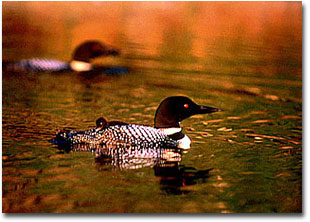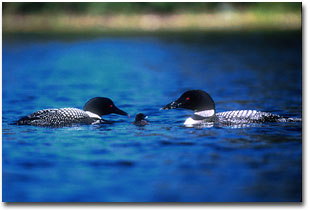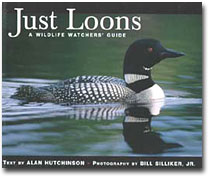|
The Camera Hunter®
Photography and Text Copyright Bill Silliker, Jr.
All rights reserved.
Photographing the Common Loon: A Master Lesson in Metering
 The common loon presents an uncommon challenge for the wildlife photographer: how to capture the two extremes of light reflectance, pure white and nearly pure black, with a single exposure setting. Even worse, the dark red eye on the common loon doesn't record well on film unless light hits it pretty straight on. In wildlife photography, if you've missed the eye, you've usually missed it all.
The common loon presents an uncommon challenge for the wildlife photographer: how to capture the two extremes of light reflectance, pure white and nearly pure black, with a single exposure setting. Even worse, the dark red eye on the common loon doesn't record well on film unless light hits it pretty straight on. In wildlife photography, if you've missed the eye, you've usually missed it all.
Most of what we record on film is reflected light. The brightness of that reflected light varies due to both the texture of the objects that we photograph and the wavelength, or the color, of the light reflected by those objects. White appearing objects reflect all colors well, and therefore, lots of light. Black appearing objects reflect little, if any light. Anyone who doubts that need only point their camera's exposure meter at a white, light-reflecting object and then towards a black, light -reflecting object in the same light.
How much reflectance can film record? That depends on its latitude. Color and black and white negative films have a wide range of latitude. Because of that, they forgive mistakes in setting the exposure when you make a photograph. A good photo lab can pull a reasonable print out if the photographer erred by as much as two stops, either over or under exposed from what might be considered a "perfect" exposure.
Color slide film has much less latitude. In fact, a slide - or chrome - shot much more than a half a stop off of the correct exposure setting is usually trash. And miss by more than that and the colors are either all washed out (overexposure), or too dark to show any detail (underexposure). Even still, as most know, professional nature photographers shoot slide film because that's what most magazines and books require for publication.
So how can you record the colors of the common loon, especially on slide film? The answer is to set your exposure for the detail that's most important. With a common loon, that's the white. If you expose for the black, which doesn't show much detail to begin with, you'll "blow out" the white so badly that it may actually look blurred.

I usually set exposures for loon photography by first metering off a subject of average reflectance such as green grass, or preferably, from an "18 percent gray" card. All camera meters are calibrated to record the light reflecting from a "gray" card as an average exposure. I then adjust the exposure setting to allow one half to perhaps even two thirds of a "stop" less light to reach the film, depending on how bright the light is that's hitting the loon. While this underexposes the black head of the loon and makes the water around a loon a bit darker than I might normally expose for, it keeps the white from blowing out and ruining the picture.
And how to capture the eye? The red eye doesn't reflect well unless light is hitting it pretty straight on. Think about when that happens. Light early in the morning or late in the afternoon strikes the earth at a low angle. Light at such a low angle hits a loon right smack in the eye. That light is also softer and not nearly as brightly reflective as the light when the sun is higher in the sky. That's a plus for loon photography, because softer light reflects more photogenically off of the white.
You also need to know how to get close enough to a loon for photography without harassing it. The first thing to do is to study a loon's behavior from a respectful distance. Watch especially how it reacts to people in boats or canoes near it. Some loons are more habituated to seeing folks in watercraft, and don't get alarmed - unless you charge up on them in a direct approach. Please never do that. We can all learn better how to make the world a safer place for loons, so that future generations may also wonder at their beauty and get a chance to feel that indefinable sensation when one calls out during the dark of night.
I almost always work from a canoe to photograph loons. And yes, I use a tripod from the canoe. The trick is to get low in the canoe by sitting on the bottom, not the seat, once you're in camera range. Then set the legs of the tripod low to get the camera at eye level. I use Gitzo tripods, as the legs spread out to accommodate a canoe of average width. But I never keep the camera strap around my neck, just in case!

Use long telephoto lenses to capture special moments with subjects as sensitive as nesting loons. While some of the nesting loon images in my book Just Loons were made from only seventy-five feet away, the approach in a canoe to these special, habituated loons often took hours and required constant vigilance for any signs of alarm or distress. I generally worked with loons at remote ponds where few others go to attempt to capture them on film. An absence of human numbers always makes for less pressure on wildlife subjects. Remember that cumulative impacts can occur on wild subjects.
You should never interfere with a nesting loon. Most jurisdictions have laws against the harassment of loons, especially at nest sites and "nursery" areas, the sheltered coves and inlets where the parents stay with newly hatched chicks. Some lakes even have loon wardens who monitor breeding loons to protect them from interference. While respecting the rules of any particular place only makes good sense, respect for the needs of your subjects makes even better sense.
Always watch your subject for any indication that it is uneasy because of your approach. You should watch a loon's body language to ensure that your presence does not affect its behavior. Learn the signs that a loon makes when it does get alarmed. Alan Hutchinson, the author for my loon book, describes those well.
If a loon displays by spreading its wings or if it calls out with a tremolo as you approach, it's probably saying that your actions have disturbed it. Back off. And if it gets up on its feet in a "penguin dance", you've definitely upset it. Get out of there immediately.
Never approach a loon in a straight non-stop method. One of my most successful techniques is to stop the canoe or boat at a comfortable distance for the loon. Then I simply float with the wind or current towards the loon. After a while, the loon may actually approach the canoe itself. Loons are very curious animals.
Sometimes when you let a loon set a distance it is comfortable with, you might be surprised how relaxed it will get in your presence. That's when you and your subject both win. And you get to photograph magic while in the presence of loons.
Catch yours in the good light.
BS-NPN
Maine wildlife & nature photographer Bill Silliker, Jr. – The Mooseman - photographed at many wild places in North America, with the results published in magazines internationally and in 9 of his own books. Bill was an instructor of wildlife and nature photography for L. L. Bean's Outdoor Discovery Program and a member of the Fuji Film Talent Team. Read more about Bill on the Camera Hunter archives page.


| 


